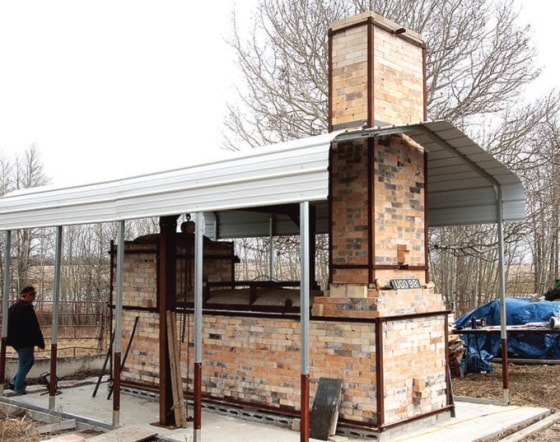In the early hours of the morning of April 27 while everyone was asleep in their warm beds, Joe Reid was busy firing his pottery kiln to 1,200 degrees C.
He and his wife, Auvery, are farmers on Reid Road near Ponoka who have a love for pottery. When they are not working with clay, they take care of the farm.
This is the second time the Reids have used their wood-fired salt train kiln; the design comes from John Neely, a potter in Utah who was inspired by Japanese kilns.
“It’s like a modern interpretation of the old Japanese climbing kilns where they fire for a week,” said Mr. Reid.
The way the Reids fire usually takes 24 hours before completed and then they let the pots cool for three or four days. Heating the kiln too fast could crack the clay with thermal shock. “It would just be too hard on the pots.”
The Reids use a special process during firing that adds iodized salt to the clay once the temperatures reach 1,250 degrees C. “We add salt to create a special effect,” added Mrs. Reid. “Orange peel is what they call it. It kind of has a stippling texture.”
The extreme temperature disintegrates the salt into its elements of sodium and chloride that help create a special look. Pyrometric cones are used to gauge the appropriate time for adding salt. As soon as they bend, Mr. Reid starts putting salt into the kiln with a modified leaf blower. These cones also give an indication of when firing is complete.
Clay test rings are also used as a visual aid to show how the glaze is settling in the clay and reveal the effect of the firing. They can only control so much during the firing process but despite that, the Reids enjoy the gamble that comes with wood firing rather than an electric kiln.
“I like the idea of fine art but I like the idea of art being something you can use in everyday life as well,” explained Mrs. Reid. “That it somehow uplifts everything you’re using every day.”
“It’s a little more accessible to some people,” added Mr. Reid.
Flames move from one side to the other and must be allowed to heat the entire kiln. The chimney helps draw air from the firebox, allowing an almost river of fire to flow through the kiln.
The electric kilns they have still serve a purpose but the effect and look of the pottery from wood firing is completely different. “There’s a lot more left up to chance. It’s a lot riskier but can bring a bigger payoff,” said Mrs. Reid.
“There’s a certain romanticism about it,” Mr. Reid said.
Their dedication appears to be paying off; they submitted pieces to be included in an Alberta Potters Association show May 3 to 23 at Webster Gallery in Calgary. Both have a piece in the juried clay exhibition.
“They’re both pieces from our very first firing,” said Mrs. Reid. “It’s nice to be included. It’s a very good group of artists.”
Not all of their work survived this second firing but the ones that did have inspired the Reids to continue using their kiln.
“It’s definitely motivation to move ahead,” she said. “We’re ready to try different processes at the next firing.”
They intend to take lessons from this firing and better the work they do. Mrs. Reid hopes to get another firing done before or after harvest time.
“The perils of the process is that it’s high risk but when you get some of the pieces it’s magnificent,” said Mrs. Reid.
Check out www.reidroadpottery.com for more details.
